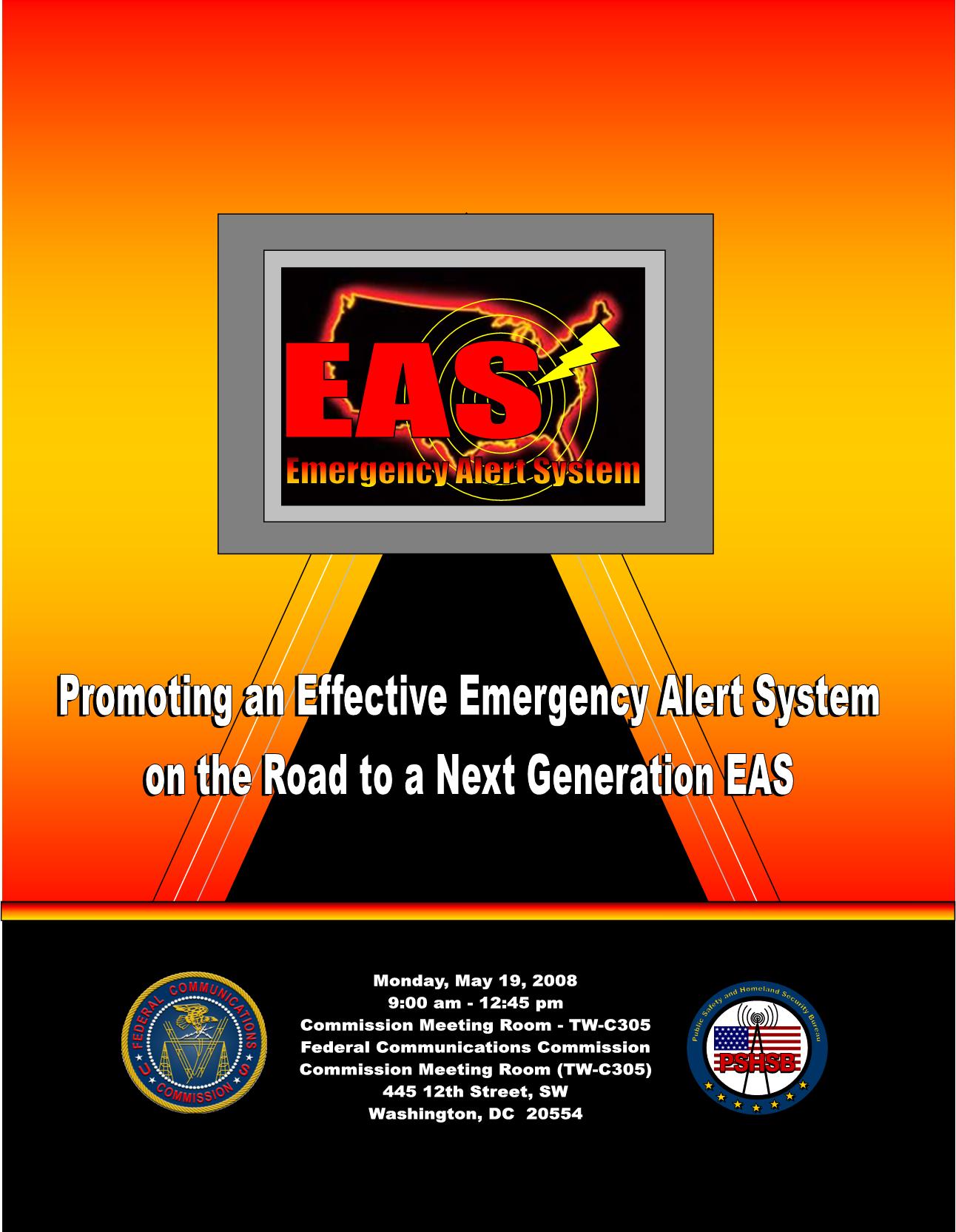- PSHSB Home
- About Us
- Advisory Committees
- Clearinghouse
- Emergency Information
- Services
- Public Safety Spectrum
- Releases
- Reporting Systems
- Summits
- Speeches and Presentations
Public Notice: Word | Acrobat
Photo Gallery: Pictures
Webcast: Event Video
The Federal Communications Commission’s Public Safety and Homeland Security Bureau hosted a Summit on the nation’s Emergency Alert System (EAS): The Making of a Robust, Next Generation Emergency Information Highway, on Monday, May 19, 2008, 9:00 a.m. – 1:00 p.m., in the Commission Meeting Room (TW-C305).
In line with the Commission’s 2007 Second Report and Order on EAS that was released last July, the Summit discussions focused on the current state of the nation’s EAS and what’s needed to transition to a more robust, next generation alert and warning system to help ensure that all citizens receive accurate and timely information during emergencies.
The agenda for the summit included two panels. Panel One was hosted by PSHSB Policy Division Chief Tom Beers. Panelists included Ann Arnold, President of the Texas Association of Broadcasters; Mark Manuelian, Chair of the Massachusetts SECC and Director of the Primary Entry Point Advisory Committee (PEPAC); Dale Gehman, President of Gehman Compliance and Consulting (Akron, PA); and Steve Johnson, Owner of Johnson Telecom (Charlotte, NC). Mr. Gehman and Mr. Johnson are long-time advisors to the broadcast and cable industries regarding emergency warning issues.
The panel presented a robust discussion of various issues relating to how the current EAS functions and how well its architecture and operations are maintained. These issues included an overview of the status of EAS player relationships, including the Federal Emergency Management Agency (FEMA); the National Weather Service (NWS); State Emergency Operations Committees (EOCs) and other state and local public safety authorities who have access to the EAS; and EAS Participants, including radio and TV broadcasters, cable and wireless cable service providers, DBS and SDARS providers, and Wireline Video service providers. Panelists then discussed the readiness of the current EAS PEP stations and the readiness of EAS delivery system architectures in the several states. Panelists agreed that the state of the EAS in individual states often reflects the degree of commitment by state and local authorities to participate in the EAS, and that a better education campaign might persuade strong and consistent investment of state and local government resources. Funding resources are key to maintaining EAS readiness, including funding directed to training state and local alert officials and staff who inject warnings and other alert information into the EAS. Training of such personnel, as well as training of EAS Participant staff regarding the proper use and maintenance of EAS equipment, is essential to prevent system mis-feeds and failure, but such training is not consistently available. Panelists advocated a more vigorous federal commitment to training programs, as well as federal funding more generally, to support the evolution of the EAS from its current "daisy chain" transmission architecture to a redundantly-designed, CAP-based Next Generation delivery system.
The second panel focused on next generation technologies and explored what policies and protocols should be implemented to ensure compatibility between Federal implementation of the Common Alert Protocol (CAP) architecture and state government operations. Panel Two was hosted by PSHSB Chief Engineer Bill Lane. Panelists included Ms. Malena Barzilai, Senior Counsel for the Association of Public Broadcasters; Mr. Art Botterell, developer of the Common Alerting Protocol (CAP) and Manager of the Contra Costa County, California, Community Warning System; Mr. Lance Craver, Program Director of FEMA’s Integrated Public Alert and Warning System (IPAWS); Mr. Clay Freinwald, from Entercom, Inc. and Chair of the EAS Committee of the Society of Broadcast Engineers; Mr. Craig Hodan, National Oceanic and Atmospheric Administration; and Ms. Suzanne Goucher, President and CEO of the Maine Association of Broadcasters.
In a lively and spirited session, panelists further emphasized funding issues mentioned in the previous panel and what states are expected to do to ensure that their state, county and local emergency response systems are fully compliant and functional in a new system design. Panelists expressed that industry and broadcasters were anxious to begin the implementation of CAP and were awaiting release and designation of the appropriate CAP protocols by the Department of Homeland Security, Federal Emergency Management Agency. In addition to re-emphasizing the need for CAP training and Federal funding for the next generation EAS, panelists urged the Federal government to assume a leadership role in defining the system architecture, establishing the CAP guidelines, and allowing industry to development the system implementation. A number of other peripheral issues were also discussed including administration of the system, authentication and verification issues for state and local emergency injects into the system, targeting of specific messages, testing programs, and equipment certification.
